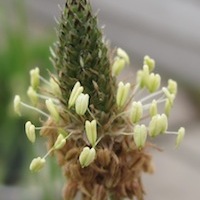
A new study of this English plantain shows that its stamens (the part of the plant that carries pollen) are specially adapted to vibrate in low-speed gusts of wind, allowing them to thrive without animal pollinators. (Photo credit: David Timerman)
If you’re a plant, and the animals or insects that pollinate you are disappearing or gone, your next best option might be wind pollination, and a new study sheds light on what adaptations are needed to make this transition.
Researchers looked at flowers of English plantain, which like most wind-pollinated plants evolved from an animal-pollinated ancestor. They used a vibration apparatus to determine the specific frequency at which its pollen-bearing stamens gained enough energy to release the pollen. Field observations show that these frequencies are achieved by eddies in normal wind patterns.
The results suggest that changing the thickness and flexibility of their stamens is one way flowers can adapt to a lack of pollinators.
Original research paper published in the Journal of the Royal Society Interface on October 7, 2014.
Names and affiliations of selected authors


